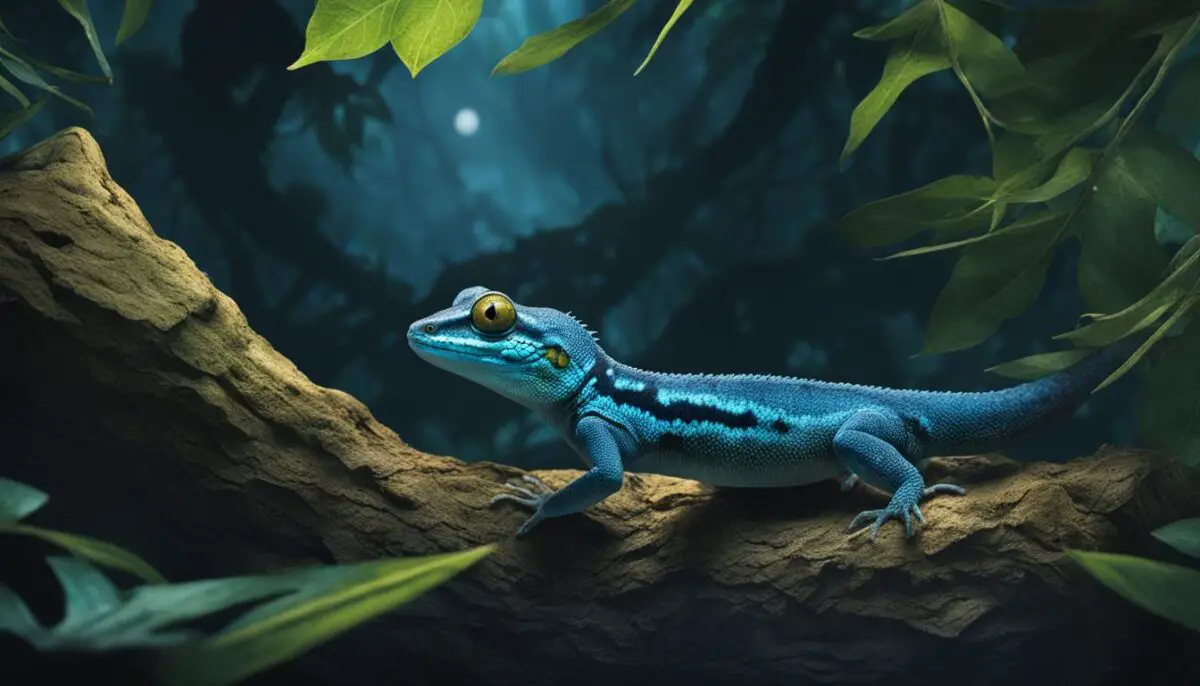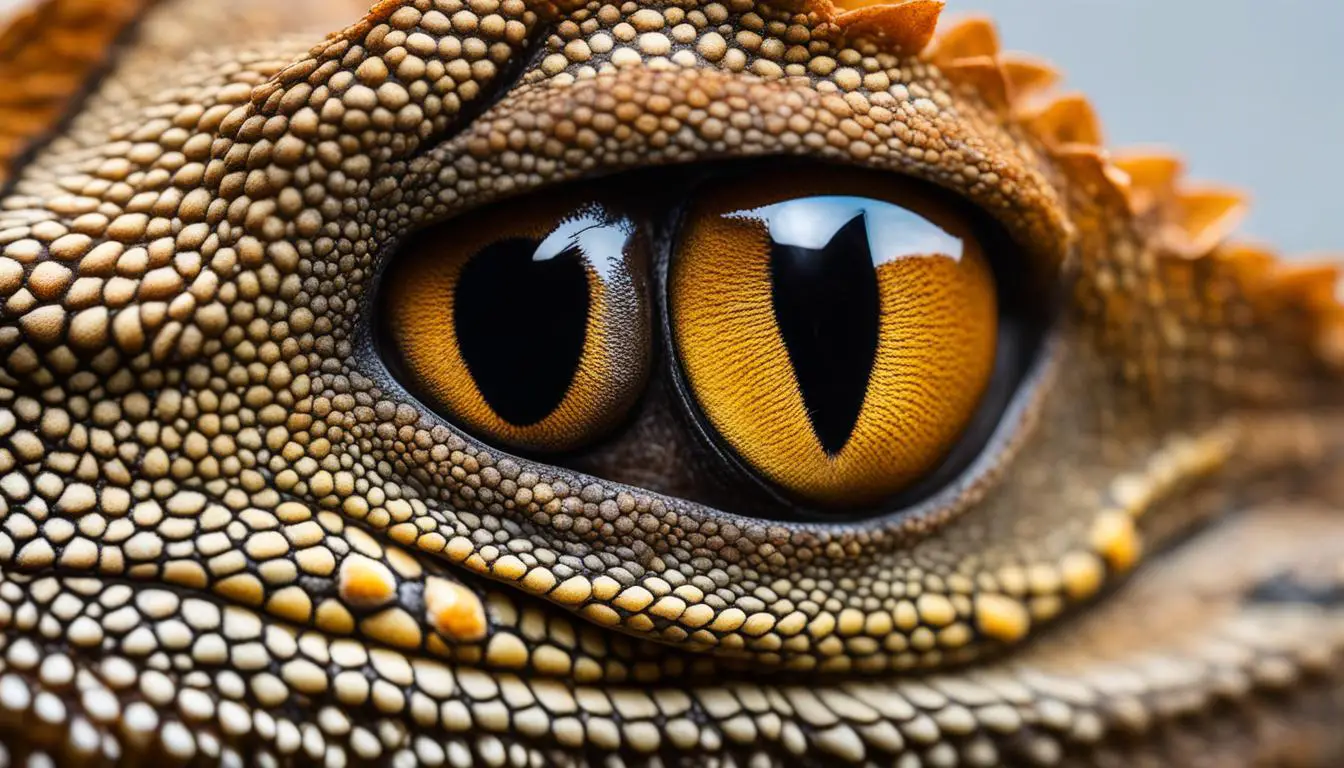Welcome to our fascinating exploration of crested gecko eyes! These nocturnal creatures have evolved to thrive in dark and low-light environments, and their eyes are a key feature that enables them to navigate their surroundings with ease. Let’s take a closer look at the unique characteristics and capabilities of crested gecko eyes.
Key Takeaways:
- Crested gecko eyes are adapted for excellent night vision and can see well in dark and low-light environments.
- Their eyes have a large size, vertical slit pupils, and irises that are often orange or rust-colored.
- Crested geckos don’t have eyelids but possess a transparent membrane that protects their eyes.
- They can distinguish colors even in low light and have eyes that are about 350 times more light-sensitive than human eyes.
- Providing a suitable environment with dim light at night is essential for their wellbeing.
Evolution of Gecko Eyes
Crested gecko eyes have undergone a remarkable evolution to adapt to their nocturnal lifestyle and optimize their night vision capabilities.
These eyes originated from diurnal lizards that possessed both rods and cones as photoreceptors for vision. However, as these lizards became more active during periods of bright light, their eyes gradually lost the rods, leaving only cones.
Over time, a group of these lizards evolved into geckos, most of which are now nocturnal and required enhanced vision in the dark. In response to this need, the cones in crested gecko eyes transformed and evolved to provide excellent night vision.
“By becoming larger and more light-sensitive, the cones in crested gecko eyes adapted to the challenges of low-light environments, enabling these geckos to navigate and hunt efficiently at night.”
This adaptation allowed crested geckos to thrive in their natural habitat, where they can take advantage of the abundance of food and reduced competition during the nighttime.
Evolution of Gecko Eyes – Key Points:
- Crested gecko eyes evolved from diurnal lizards that had both rods and cones as photoreceptors.
- As these lizards became more active during bright light, they gradually lost their rods, retaining only cones.
- Geckos, including crested geckos, evolved from these lizards and required enhanced night vision.
- The cones in crested gecko eyes evolved to become larger and more light-sensitive, facilitating superior night vision.
- This adaptation allows crested geckos to navigate and hunt effectively in low-light environments.
To complement the discussion of crested gecko eyes’ evolution, let’s take a closer look at their anatomy and understand how their unique features contribute to their exceptional night vision capabilities.

Creating the right environment is vital for the well-being of your crested gecko, especially during their nighttime activities. A dimly lit environment mimics their natural habitat and helps to maintain their natural sleep-wake cycle. Here are some tips to create the perfect environment for your crested gecko at night:
- Dim the lights: During the night, it is important to provide low levels of light in the room where your crested gecko is kept. This can be achieved by using a low-wattage bulb or a dimmer switch for their enclosure.
- Avoid direct sunlight: Placing the vivarium in direct sunlight can result in overheating and discomfort for your crested gecko. Ensure that their habitat is located in a shaded area or away from direct sunlight.
- Allow natural night light: Allowing dim light or moonlight to enter the room at night is beneficial for crested geckos. They do not require UVB light and can thrive with the ambient natural light in the room.
- Maintain a day/night cycle: It is important to maintain a consistent day/night light cycle for your crested gecko. During the day, ensure that some indirect light enters the room to signal to your crested gecko that it is daytime and time to sleep.
“A properly lit environment is essential for the well-being of crested geckos at night. Mimicking their natural habitat with dim light and avoiding direct sunlight helps them maintain a healthy sleep-wake cycle.”
By creating a suitable night environment for your crested gecko, you provide them with the conditions they need to thrive and stay healthy. Remember to monitor the temperature and humidity levels in the enclosure to ensure optimal living conditions for your reptile companion.
Signs of a Happy and Thriving Crested Gecko
A happy and thriving crested gecko exhibits several signs that indicate its well-being and contentment in its environment. As a responsible pet owner, it’s important to be aware of these signs to ensure the optimal care and happiness of your crested gecko.
- Alertness and Activity: A happy crested gecko will be alert and active when handled. It will move around and explore its surroundings, showing curiosity and engagement.
- Smooth and Soft Skin: Healthy skin is another indication of a happy crested gecko. Their skin should be smooth and soft to the touch, without any signs of dehydration or stuck shed. Regular shedding is a natural process for crested geckos, and a healthy gecko will shed its skin easily without any issues.
- Bright and Clear Eyes: Bright and clear eyes are a sign of good health in crested geckos. The eyes should be free from any swelling, discharge, or signs of infection. It’s important to observe your gecko’s eyes regularly to ensure their well-being.
- Healthy Appetite and Regular Eating: A healthy crested gecko will have a good appetite and exhibit regular eating habits. They should eagerly consume their food and show interest in the food you provide. Regular eating is an indication of a well-nourished and happy gecko.
- Comfort and Interaction: Lastly, a happy crested gecko will exhibit a level of comfort and interaction with its owner. It may become accustomed to handling and show trust in its owner. Building a bond of trust and interaction is beneficial for both the gecko and its owner.
By observing these indicators, you can ensure that your crested gecko is happy, thriving, and living a fulfilling life in its environment. Regular monitoring and care will help you create a strong bond with your pet and provide the best possible care to ensure their well-being.
Image: A happy crested gecko displaying signs of good health and well-being.
Conclusion
Crested geckos are truly remarkable pets. Their unique evolutionary journey from diurnal lizards to nocturnal geckos has equipped them with extraordinary visual capabilities. Their ability to see clearly in the dark and distinguish colors even in low-light conditions is a testament to their incredible adaptation.
Providing the right environment is crucial for the wellbeing of your crested gecko. Ensuring that they have dim light at night and receive indirect light during the day mimics their natural habitat and helps maintain their overall health. By creating a suitable environment, you can help your crested gecko thrive.
Understanding the signs of a happy and thriving crested gecko is essential for any pet owner. By observing their alertness, activity levels, smooth skin, bright eyes, healthy appetite, and level of interaction with you, you can ensure that your crested gecko is content and living a fulfilling life as a beloved pet.
So if you’re considering a pet that is both fascinating and visually stunning, a crested gecko may be the perfect choice. With their unique visual capabilities, ease of care, and rewarding interactions, crested geckos can bring joy and wonder to your life as a cherished pet.
FAQ
Are crested geckos nocturnal?
Yes, crested geckos are nocturnal animals. They have evolved to be active during the night and have excellent vision in dark and low-light environments.
How have crested gecko eyes evolved?
Crested gecko eyes have evolved from diurnal lizards that used to have both rods and cones as photoreceptors for vision. Over time, they lost their rods and developed larger, more light-sensitive cones to enhance their night vision.
What are the characteristics of crested gecko eyes?
Crested gecko eyes are characterized by their large size, vertical slit pupils, and often orange or rust-colored irises. They do not have eyelids but have a transparent membrane that protects the eyes.
Can crested geckos see well in the dark?
Yes, crested geckos have excellent night vision and can see well in dark and low-light environments. Their eyes are about 350 times more light-sensitive than human eyes.
Do crested geckos have color vision at night?
Although no scientific research has been done specifically on crested gecko color vision at night, it is possible that they have photopigments (cones) that are sensitive to UV, blue, and green, allowing them to distinguish colors even in low light.
How should I create a suitable environment for my crested gecko at night?
To provide a suitable environment for your crested gecko at night, it is recommended to dim the lights and create a normal day/night light cycle similar to their natural habitat. Avoid placing their vivarium in direct sunlight to prevent overheating.
What are the signs of a happy and thriving crested gecko?
A happy and thriving crested gecko exhibits signs such as alertness and activity when handled, smooth and soft skin without signs of dehydration or stuck shed, bright and clear eyes without swelling or discharge, a healthy appetite and regular eating, and a level of comfort and interaction with their owner.

